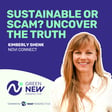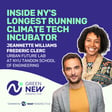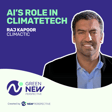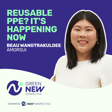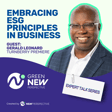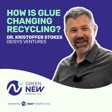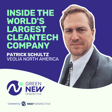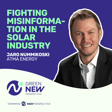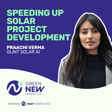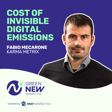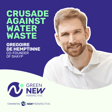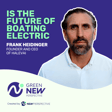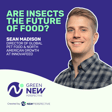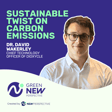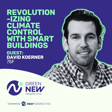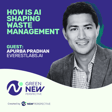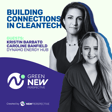Introduction to the Green New Perspective Podcast
00:00:00
Speaker
Hello friends, you are watching a brand new episode of the Green New Perspective Podcast. Go to place when you want to learn more about innovative tech aimed at combating climate change. In today's episode, my guest is Laura Fieselman from the company called Salient Predictions. And Laura is going to tell us how accurate weather predictions can help businesses to stay resilient in the future. If you want to learn more, stay tuned and enjoy.
Meet Laura Fieselman: Sustainability and Salient Predictions
00:00:33
Speaker
Laura, and welcome to the Green New Perspective Podcast. Hi, Nuna. Thanks. It's great to be here. For starters, can you briefly introduce yourself to our audience and tell us a bit more about your role and interest in climate solutions? I'm Laura Fuselman. I lead operations here at Salient, which means that I hold finance, people, business operations,
00:00:55
Speaker
commercial operations, non-dilutive funding, marketing, all company admin, all that to say it's never a dull day. And I come to this work initially from the world of sustainability. I started my career as a sustainability officer, back when you could do that just out of college. And I spent about a decade opening and managing sustainability offices for colleges and universities. And then I pivoted to mission driven startup world in 2018.
00:01:23
Speaker
I've always been in COO and chief of staff type roles and mission-driven startups are my jam. I've always cared about sustainability and climate and I'm delighted to continue to be in this space.
00:01:35
Speaker
Can you give me a brief overview of the company and what climate related problems are you trying to solve? Salient is
What is Salient Predictions?
00:01:42
Speaker
a weather forecasting company that's focused on the S2S time horizon. And let me tell you what S2S means for the listeners that aren't familiar. It's seasonal to sub-seasonal weather forecasting. So about a week to a year ahead. And everyone always says, okay, Salient, interesting, but how do you forecast the weather nine months ahead?
00:02:02
Speaker
And the answer is that the short-term weather, like in the next day to two weeks, is generally governed by the atmosphere. And in the longer term, weather is governed by the ocean because oceans hold the bulk of both the heat and the water on our planet. What we are doing is taking
00:02:25
Speaker
A bunch of ocean data and also land data together with atmospheric data of shorter term weather forecasts and feeding all that through a machine learning engine.
00:02:36
Speaker
to spit out S2S or seasonal, sub-seasonal weather forecasts. And I'll brag on my team a little bit. I can do that because I'm not on the R&D side of the house, but Sanlian's got the most accurate, reliable S2S weather forecast commercially available today. Generally, our accuracy is 10 plus percent over the next best available model for various season, geography, lead time, et cetera. And just to briefly orient you and the listeners to the product, we're forecasting temperature,
00:03:06
Speaker
Precipitation, wind, and solar irradiance as our core variables, plus a whole bunch of derived variables, things like growing degree days, heating degree days, relative humidity, soil moisture, et cetera, one week to a year ahead, anywhere that there's land. That's what we do. What
Industries Benefiting from Long-Range Forecasts
00:03:24
Speaker
challenges are you trying to solve with your tech?
00:03:27
Speaker
Our core salient is helping businesses profit and organizations create positive impact in the world by using advanced long range weather forecast and analytics. And Dunya, I'll say that our current core verticals where we work, our energy, agriculture,
00:03:47
Speaker
and insurance. There's a lot of other potential verticals where good weather forecasts far in advance are helpful. Things like retail, shipping, defense, etc. There's so many. But right now,
00:03:59
Speaker
We are focused on energy, ag, and insurance, and they're a handful of use cases inside each of those verticals. I'll give you just some examples to orient you in the listeners. Inside the world of energy, we've got power and gas traders using our forecasts. We've got hydropower hedging, utility planning, everything from vegetation management ahead of wildfires to putting storm crews in place ahead of storms.
00:04:23
Speaker
Demand forecasting, renewable supply forecasting, so many corners of the grid are weather dependent at this point. In the world of agriculture, we've got commodity traders using our forecasts and supply chain planners. And then in insurance, use cases include things like pricing, but also customer alerting.
00:04:44
Speaker
Yeah, wide variety of different ways in which salient is helping to solve challenges in the business world.
The Origin of Salient Predictions
00:04:51
Speaker
Can you tell me more about the complexities of weather systems and how changes in one area can affect conditions globally? Let me briefly tell you the company's origin story, which is that our co-founder, Dr. Ray Schmidt, who's an oceanographer by training, originally had this hypothesis that we can correlate ocean salinity to
00:05:11
Speaker
precipitation because the ocean is saltier. Water evaporated that's going to come somewhere else. So he's at the tail end of a science career, but he has sons build a machine learning model.
00:05:23
Speaker
things, salinity, precipitation. And they entered the U.S. Bureau of Reclamation forecasting rodeo with their model, delivered a precip forecast week on week for a year, won in the precipitation category, took the prize money, eventually hired the person that won in the temperature category and started the company. That's the heart of
00:05:46
Speaker
The answer to your question, which is like, how and why does ocean over here affect weather over there? How Salient's tech help different sectors to manage the risks associated with unpredictable weather patterns? There are so
Global Impact: From Farmers in Africa to Brazil
00:06:01
Speaker
many applications. Let me just give you a couple examples. One, the Bill and Melinda Gates Foundation is working with Salient to make our S2S weather forecasts available to small folder farmers in East Africa.
00:06:16
Speaker
who are making all kinds of decisions, like what to plant, when to plant, which variety to plant, when to harvest. And those are really difficult decisions in an environment where agriculture is primarily rain-fed. Or let's take the Texas freeze as an example of 2021 when winter storm Yuri knocked out so much of the grid in Texas. Stanley caught a signal on that event
00:06:42
Speaker
four weeks ahead of time and, you know, think about helping to solve that kind of challenge with a bunch more lead time. Very helpful. And then another example that I can give you where we're helping companies handle natural disasters is our work with Zurich Santander in Brazil where
00:07:01
Speaker
Big rain events create mudslides, which negatively affect their customers and a lot of other people, of course. And Zurich Santander is working with Salant to put together alerts for their commercial and industrial customers ahead of those major rain events to prevent disaster and losses. Can you share a success story on how you helped a client to make a significant difference, like disaster preparedness or resource management?
How Do Probabilistic Forecasts Help Businesses?
00:07:32
Speaker
of our customers are managing weather-dependent enterprises in some form or another. And basically, what our product does is either help them make money or lose less money based on what happens with the weather. To go a level deeper there, Salient is creating probabilistic weather forecasts that inform decision-making. And when I say probabilistic weather forecast, what I mean is that I'm not saying in July the average
00:08:01
Speaker
We're saying here's the range of potential outcomes for temperatures in July, for example.
00:08:08
Speaker
And making decisions off a probabilistic range of outcomes is a difficult thing to do and requires a sophisticated decision maker. And so, Dunya, I was thinking about how to help your listeners understand the core. How does one do that? And the cost-loss framework is a tool that comes to mind. I'll briefly explain it. It's a pretty basic two-by-two, but it's a powerful one, where what we're thinking about is across the top of the matrix, does the weather event occur or not?
00:08:38
Speaker
And across the, down the side of the matrix, was the preventative action taken or not taken? And to use a cost-loss matrix, what you do is you figure out the cost of taking a preventative action, the cost of a loss if the weather event occurs without the action, the probability of the weather event, and then you do some math.
00:09:00
Speaker
A matrix like this ultimately spits out is the threshold probability above which it makes sense to take a preventative action. That's the ratio of the cost of the loss, cost-loss ratio. And yeah, this is the critical question that decision makers have to make. Is the cost of taking an action less than the expected loss from the event, given the event's probability?
00:09:25
Speaker
you know, it sounds simple. We make probabilistic weather forecasts, but making decisions off those forecasts isn't easy. So, yeah, requires decision-making models and frameworks. And this is one I'm happy to point you and your listeners, if you're able to add show notes to a written post where we explain this in a lot more detail. Another client that I can speak about publicly is St. Leon's work
Success Stories: Anheuser-Busch and Zurich Santander
00:09:51
Speaker
with Anheuser-Busch or ABNDev.
00:09:54
Speaker
who makes so much of our beer. And the question, well, basically, beer is made from barley. And in a wet year, barley quality degrades. And in a dry year, barley quantity degrades. And so the sort of deep dive on what Salient and AP and Bev have been doing together is looking at how
00:10:18
Speaker
you know, longer range weather forecasts up to a year in advance can help with barley supply chain sourcing. So maybe you know this, maybe you don't, but weather actually causes more variability crop production than anything else, not soil, not land, not farmer skill, not plant genetics. The weather accounts for 40 to 80% of crop yield variability. And in this day, when the range of weather outcomes is
00:10:44
Speaker
are greater than the historical range of possibilities. Just relying on historical data is less and less helpful. So what we did was run a pilot with AB and Bose North American Acronomy Group with attention to procurement and trading as well to look at volume, quality, and risk as pieces of the puzzle. And I'll just give you some examples of what's possible in a pilot like this.
00:11:10
Speaker
So in 2021, there was a major drought in the Midwest where fields just didn't have enough moisture to support barley and oat crops. And salient caught that signal in August of the prior year. And then again, in 2023, in the spring, we caught the signal on a below normal precipitation summer.
00:11:30
Speaker
you know, two to five months ahead. And those kinds of predictions are really valuable if we can turn them into business value. So let me just speak briefly to how we take a forecast like that and translate it into business value. That looks like is the procurement team or the group at AB in BEV that buys grain accounting for decreased yields in their planning, contracting for more grain, shifting regional applications. That's things like the agronomy group.
00:11:59
Speaker
the group that advises farmers, advising farmers to buy less nitrogen to improve grain quality and acceptance rate. And it's things like the trading group or the group that hedges prices in advance to be able to anticipate price and supply risks and improve their hedges and forward contracting. But Junya, I want to flag it's not just all about the economics. When we factor in
00:12:24
Speaker
the community implications of farmer incomes and the ecosystem implications of the environment.
00:12:30
Speaker
Projects like these are win-win-win collaborations. I would like to stir this conversation in a bit of a different direction at this point.
Remote Work Culture at Salient Predictions
00:12:38
Speaker
So I know that Salient is a fully remote company and your perspective in marketing agencies bothering these podcasts is also a fully remote operating agency. So I would like to ask you, how do you feel in that kind of environment and how do you manage collaboration and maintain team cohesion?
00:12:56
Speaker
We can't talk about remote culture without talking about the pandemic. And at the top of the pandemic, Salient was about a five person team, everybody in Boston or Boston area. And now we are about now being May 2024. We're about a 17 person team spread across the US and world. And I think we've got a pretty strong remote culture and I feel proud of it.
00:13:22
Speaker
And I would say, you know, there's the small things, but also the big things that add up to create to build a team's culture. A hand, some of the small things that I think make a difference for us are we run synchronous hours for the company. So 11 a.m. to 4 p.m. Eastern are the hours in which we're all online. We host our internal meetings during that block.
00:13:46
Speaker
And otherwise, you can work whenever you want. So that gets all of us spread across a bunch of different time zones. I think we've got Croatia to Alaska as our time zone spread, all working for five hours a day together. Another thing we do is meeting free Wednesdays, or at least internal meeting free Wednesdays, which unlock deep work blocks and
00:14:10
Speaker
I'm, you're probably familiar with Cal Newport's deep work frameworks, but it's one of my favorite and the whole team loves no meeting for you Wednesdays. We get so much done and small way that we build cultures. We've got recreational Slack channels. I know a lot of companies have these. Some of our favorites are animals and kids, food and drink, my ride and
00:14:33
Speaker
Our CTO, Karl Kritz, made a really fun Jeopardy! game on our last offsite, off these recreational channels. So we like to have fun like that. In the camp of bigger things that we do is run company retreats with a lot of thoughtfulness and care. We have them about three times a year and they're always a mix of work and play. And when we get together, the team is problem solving or building relationships.
00:14:59
Speaker
We're having fun. The agenda is a mix of formal sessions, co-working, walk and talks, adventures together. And we've had these retreats at a number of different locations so far. Boston, where the company's headquartered. Cape Cod, where co-founder Ray did his academic work at the Woods Hole Oceanographic Institute. We've been to the Rocky Mountains. A shout out to YMCA at the Rockies, Snow Mountain Ranch, for a really cool facility. And we're actually headed to
00:15:27
Speaker
Tulsa, Oklahoma next week. We will have been already by the time the podcast comes out. We're in partnership with the University of Oklahoma's meteorology school. One of our investors is based there. We've got an employee working out of the Roserock Bridge incubator. So yeah, we're really forward to that as a
00:15:45
Speaker
new retreat adventure for us. And what do you feel are advantages of remote work and where do you see challenges? One
Remote Work: Opportunities and Challenges
00:15:53
Speaker
of the obvious advantages is remote work enables us to recruit some of the best talent, no matter where people are in the world. Shout outs to my colleagues, Fran Bartolik and Victor, who are in Croatia and PhDs in machine learning and data science. They're amazing contributors to the team and we wouldn't be able to get them if we were
00:16:14
Speaker
a strictly in-person US-based company. One of the challenges to remote work is for people who have self-motivation or have a bunch of distractions at home, it can be hard to show up.
00:16:27
Speaker
uh, remotely. And then I think maybe the bigger challenge is supporting our early career team members and growing as early career professionals. To be someone just starting out in the professional world and working remotely, you got to really push yourself to build relationships, have mentors, attend events, listen, learn, read, have introductory coffees. And as a manager, I try really hard to support
00:16:57
Speaker
my team members in doing that. And we do all across salient. So that's, I think, a challenge that company leadership has to attend to. But I'll end on a positive note and just say that, of course, the win of remote culture or remote work is that we get to have these really fun retreats. I really enjoy them.
00:17:16
Speaker
Since a marketing agency is behind this podcast, of course, I have to ask some of the marketing related questions. So how
Educating Clients on Forecasting's ROI
00:17:24
Speaker
do you educate your market on the importance of accurate long range forecast? And why is that important?
00:17:31
Speaker
There's a few lines on which we have to educate. One is on the science of what we do. We are tackling a complex scientific challenge of weather forecasting a week to a year in advance. And some of our customers care a lot about how we do that and want to know the details. And other customers don't care at all. They just say, give me the answer. That's the weather forecast. And so
00:17:59
Speaker
We have to have a range of education for those varying levels of interest in the science. And then similarly, we have to do a fair bit of education on the ROI of deploying good, reliable, accurate, S2S weather forecasts. Because a forecast can be as accurate and reliable as humanly possible or as technically possible, but doesn't do any good if you don't make decisions and if a business doesn't get an ROI off the forecast.
00:18:27
Speaker
We work closely with our customers to quantify that ROI. It's not always easy to do. We've got a technically complex product. I've mentioned earlier, you know, we're providing probabilistic weather forecasts and those are opposed to deterministic forecasts. So again, not here's the temp average for July, but rather here's the range of potential outcomes. Each forecast comes with a reliability diagram. You know, here's the,
00:18:55
Speaker
Here's the reliability of salience forecast at this geography for this lead time for both reliability. Also, each forecast comes with a skill score. I'll briefly pull you into the world of skill score metrics by telling you that my team's favorite skill score metric is CRPSS, or continuous ranked probability skill score, which is a measure of both
00:19:24
Speaker
accuracy and reliability at the same time. And every forecast comes with both that skill score and a suite of others. All this to say, it's a technically complex product and we have to really help our customers understand, depending on their level of sophistication, education, what all is in the product and how to use it. The other thing I'll say is that World of AI and weather is evolving really rapidly. There's a lot of new players.
00:19:51
Speaker
Some of the science is strong, much of it is somewhat lacking in the field, and it can be hard for customers to parse the difference between all the players and the range of science. And so we have to work at that with our customers. Can we talk more about how you build long-term relationships with clients and partners to advance climate resilience?
Building Client Relationships: Starting Small
00:20:12
Speaker
Most of our clients are large multinationals, not all of them, but many of them.
00:20:17
Speaker
And S2S weather forecast is relevant for a lot of different business units across the company. There's an ROI to be had off of S2S weather forecast across a range of different use cases. And we get excited about helping a bunch of different corners of the business. But what we have to do is stay focused, start small.
00:20:35
Speaker
build a relationship within one business unit on a team, prove value, and then we can expand. Our conversation is slowly coming to an end. And one of my last questions for you is, how do you see, what's your long-term vision for weather forecasting? At the heart
Enhancing Resilience with AI-Driven Forecasts
00:20:51
Speaker
of our vision is that the private sector, the public sector, and society at large will all benefit from the improving resilience to a climate that's increasingly volatile.
00:21:05
Speaker
And again, our vision is not just excellent forecasts, but empowering decision makers across those sectors, public and private, to translate effective, excellent forecasts into decisions that drive business value and or create impact. And what are some of the exciting innovations and advancement in forecasting tech? Again, this world of AI and weather forecasting is evolving really rapidly.
00:21:33
Speaker
Let me just point you and the listeners to some things that are changing. One is that the skill of forecasts on this S2S seasonal, sub-seasonal, one-week, one-year time horizon is evolving really rapidly. And the value of superior S2S forecasting is becoming really clear to decision makers who have been relying just on climatology, historical averages.
00:21:58
Speaker
Another thing that's changing where this industry is going is that AI-based S2S forecasting is becoming a really important tool for sophisticated weather data users and the meteorologists who are overly skeptical of AI and S2S are unfortunately falling behind their more forward-thinking counterparts.
00:22:20
Speaker
And then the other thing that's changing in the business world is that decision-making models that have taken deterministic weather forecasts are being refactored into decision-making models that can accept probabilistic forecasts as this evolution towards probabilistic weather forecasting happens. And then beyond the business world, government agencies are increasing their commitment to AI and S2S forecasting
00:22:49
Speaker
We see this both in the US and Europe and beyond, and partnerships between government and private sector are becoming core to progress in this space. And then the other thing we see is the scientific research community continuing to push the envelope on what's possible in this space. And then, so sort of that's industry overview altogether. I'll say close to home, what salient is able to do is
00:23:16
Speaker
collaborate really closely with our customers to hear what geographies are most important, what lead times are most important, what seasons are most important. And then we focus our model skill improvements against those customer priorities. So we love getting to do that and we'll continue doing it.
00:23:33
Speaker
My last question for you is pretty much the same one that I ask all of my guests here in the podcast. So can
Stay Connected with Salient Predictions
00:23:39
Speaker
you share some of the resources for people who are listening and want to join the climate community? Resources like Slack channels, Discord channels, different kind of groups or web pages. And also can you share your social media links, social media of salient, so they can people learn more about weather predictions and why that matters.
00:23:57
Speaker
Yeah, sure. A couple resources in the climate community that I often point people to have been really valuable for me are the two Slack communities. One, work on climate.
00:24:08
Speaker
and two, New Energy Nexus. Both have tens of thousands of people in them and very robust conversations across all kinds of channels. I'm sure you get those recommendations a lot. To get in touch with Salient, you can book a call through our website or a demo directly. And I would say follow us on LinkedIn. It's a social channel where we're most active. And of course, please connect with me directly on LinkedIn. Love to be connected to more people in this space.
Conclusion and Call to Action
00:24:46
Speaker
Thank you for watching another Green New Perspective episode and sticking with us for the second season of our podcast. As before, this episode is proudly sponsored by New Perspective, a Boston-based marketing agency working with clean tech clients only. So if you want to learn how our sponsor is helping clean tech businesses to grow, click out the link in the description of this episode and find
00:25:10
Speaker
out a lot more on their website and on their social media. And if you want to support Green New Perspective podcast, subscribe to our podcast on all the streaming platforms. We are everywhere and we love you and we love your feedback. So thank you once again for joining this podcast episode and hopefully I'll see you in the next one. Bye.

